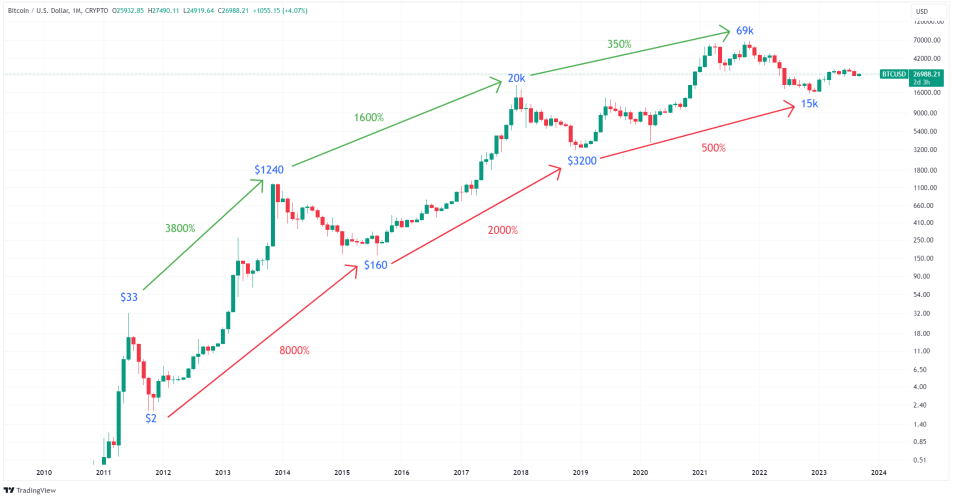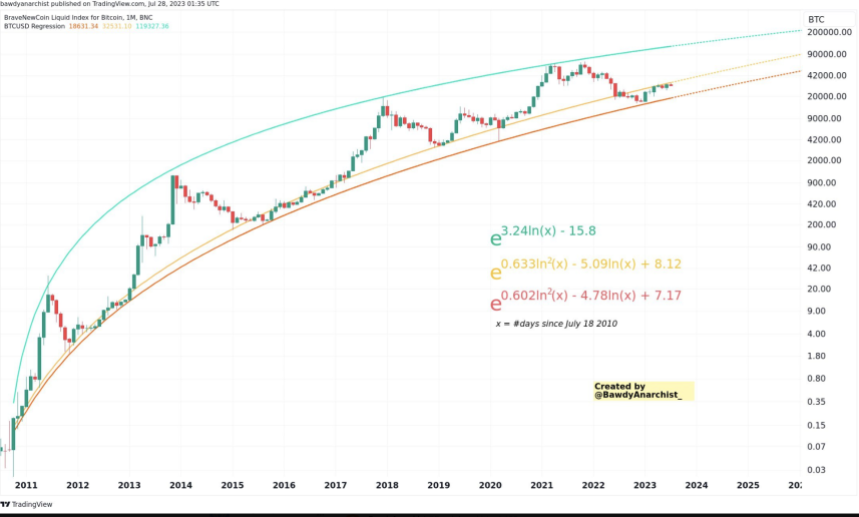The Bitcoin price is trading at $27,100 at the time of writing, marking a 60% decline from the 2021 all-time high of $69,000. As anticipation for the next bull market increases, questions arise about the potential future prices of Bitcoin.
While most predictions are speculative, one analyst has come up with a model that uses historical data to predict potential tops and bottoms in Bitcoin’s price over time.
Bitcoin price in previous cycles

Bitcoin's prices changes since 2011. Source: BTCUSDT on TradingView
Since its inception, Bitcoin has shown remarkable growth, substantially rewarding early long-term investors. This price growth is observable when measuring Bitcoin prices from the lows to the highs and between the highs of successive bull markets.
In 2011 the peak was $33, followed by a peak of $1240 in 2013, reflecting a 3800% increase between peaks. The subsequent peaks in 2017 and 2021 were $20,000 and $69,000, representing increases of 1,600% and 350% respectively. Similar levels of increase are also observed when examining the lows of different cycles.
Notably, relative growth between cycles has declined, possibly due to the increase in Bitcoin’s market capitalization, which requires more substantial capital to influence its price. This declining growth corresponds to a mathematical pattern known as logarithmic regression.
Logarithmic regression
An analyst has devised several logarithmic curves on the Bitcoin chart to predict Bitcoin’s potential tops and bottoms, using time as the only input. Such models can help investors by providing an easy way to see potential market trends and make proactive plans in the unpredictable world of cryptocurrency.

Chart of Bitcoin's price in a channel of logistic regression curves. Source: @BawdyAnarchist_ on X
Bitcoin’s tops and bottoms typically manifest every four years, allowing potential Bitcoin prices in upcoming cycles to be predicted based on the logarithmic regression model.
Bitcoin Price Projections
- 2025-2026: The Bitcoin price could peak between $190,000 and $200,000 in the third or fourth quarter of 2025, before bottoming out around $70,000 the following year.
- 2029-2030: The Bitcoin price could reach a high of $420,000 to $440,000 and hit a low of around $230,000 the following year.
- 2033-2034: Bitcoin’s price could peak between $750,000 and $800,000 and reach around $700,000 the following year.
Towards the end of the 2030s, the model begins to break down as the predicted highs begin to fall below the predicted bottoms, possibly indicating a stabilization in Bitcoin’s price after the $750,000-$800,000 peak.
Final thoughts
While models like these provide insightful projections of Bitcoin’s potential future prices, it is important to recognize their limitations and the need for periodic updates with new data points. Numerous external factors, including but not limited to regulatory changes, technological advances, and macroeconomic conditions, can significantly affect the model’s accuracy.
Furthermore, the unprecedented nature of Bitcoin’s trajectory, which has never endured a recession, implies a potential susceptibility to more substantial crashes than models might predict. Forecasts should be considered cautiously in broader market analyzes and trends, as with any financial model.
Investment Disclaimer: The content in this article is for informational and educational purposes only. It should not be considered investment advice. Consult a financial advisor before making any investment decisions. Trading and investing involve significant financial risks. Past performance is not an indication of future results. No content on this site is a recommendation or solicitation to buy or sell any security or cryptocurrencies.
Featured image from ShutterStock, charts from TradingView.com

